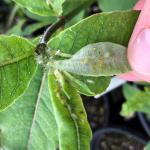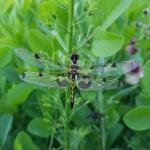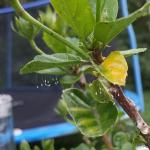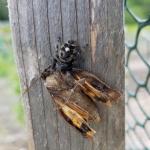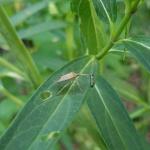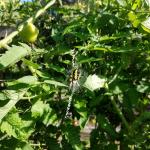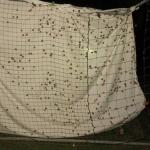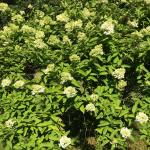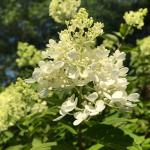A monthly e-newsletter from UMass Extension, published March to October, for home gardeners.
To read the articles in each section of the newsletter, click on the section headings below to expand the content:
Tips of the Month
August is the Month to.....
-
Plant cool season crops for fall harvest. Cool season leafy crops such as lettuce, kale, swiss chard, mustard greens, collards, broccoli, and root crops such as carrots, beets and radishes, can be planted in late summer for fall harvest, as well as fast growing herbs such as basil and cilantro. After harvesting the first crop planted in spring, remove leftover debris like stems and roots, as well as weeds. Before planting the fall crop, prepare the soil by tilling or spading to a depth of at least 6-8 inches and mix in some balanced fertilizer to replace nutrients used up by earlier crops. Most leafy and root crops can be direct seeded. Seeds are sowed thickly in rows and thinned later to the desired stand to allow them to develop properly. Root crops such as carrots, beets, and radishes are thinned to a 2-inch spacing as soon as they reach small edible size. Transplants are preferred for leafy vegetables such as kale and chard, as they establish faster and mature early. Lettuce and spinach seeds may not germinate if the soil temperature exceeds 75 degrees F. To keep the soil cool and moist, cover the seeded area with a light mulch and remove it as soon as the seed germinates.
-
Harvest onions. When over half of the tops have fallen over and start to dry, the onions are ready to harvest. Carefully pull or dig the bulbs with tops attached. After harvesting, dry (cure) the onions in a warm, dry, well ventilated location. Spread the onions in a single layer on a clean dry surface. Cure the onions for two to three weeks until the tops and necks are thoroughly dry. After the onions are properly cured, cut off the tops about 1 inch above the bulbs. Discard any onion bulbs that show signs of decay. Place the cured onions in a mesh bag, wire basket or crate that allows air to circulate through the onions. Store the onions in a cool, moderately dry location. Storage temperature should be 32 – 40 degrees F with a relative humidity of 65-70%.
-
Remove new flowers on tomato plants. Tomato fruits require eight to nine weeks to ripen after flower set. Flowers that form in August will not have enough time to produce fruit that will ripen before frost. Removing the flower clusters that form in August will give the remaining fruits a greater chance to ripen.
-
Plant perennials. Late summer is a good time to plant many perennials. It also is a good time to move or divide perennials, such as peony, daylily, and garden phlox. Perennials planted in late summer should be mulched with 3 - 4 inches of organic mulch such straw, pine needles or other materials in late fall. Mulching helps prevent repeated freezing and thawing of the soil that may heave plants out of the ground. Drying of exposed plant crowns and roots can severely damage or kill plants.
-
Remove and discard diseased plants. Start garden clean-up by removing and discarding diseased plants from flower and vegetable garden beds. Do not compost diseased plants; dispose of them in the trash or in an area away from the garden. Leftover disease free debris can be tilled into the soil at the end of the season, where it will decay and enrich the soil with organic matter.
-
Prune off suckers and water sprouts from fruit trees and some ornamentals. Fruit trees and some tree species such as crabapple produce suckers and water sprouts annually throughout their life, so removing them is part of regular maintenance. Suckers are vigorous shoots that grow from the trunk or roots. Water sprouts are rapidly growing upright shoots that develop along branches. The water sprouts are usually weakly attached and generally do not flower or fruit as profusely as the other branches. Suckers and water sprouts can be pruned off any time in the summer.
-
Late summer through about the end of September (with Labor Day being the preferred target date) is the best time to start a new lawn or to seed bare spots in an established lawn; the warm days and cool nights are ideal for seed germination and seedling growth. Soil testing to determine the nutrient status and pH of your soil is an important part soil preparation; go to soiltest.umass.edu for soil testing options. Any necessary site work or soil amending should be done prior to seeding.
-
Plant a cover crop of oats in vacant parts of the garden. Oats are a cool season annual grass that grows well during the fall. As a cover crop, oats help with weed suppression, reducing nutrient loss, and erosion control. Oats are frost killed, so they do not survive the winter. Enough growth is needed before first frost to adequately protect the soil, so oats should be planted in mid-August. Oats create a winterkilled groundcover that is easily incorporated into the soil as a green manure before planting vegetables the following spring.
Geoffrey Njue, UMass Extension Sustainable Landscapes Specialist
Timely Topics
Coming Soon: Grass Planting Time
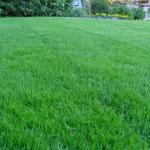 While we remain in the dog days of summer in August, it is beneficial to look ahead to the ‘primary establishment period’ for cool-season grasses, which is right around the corner. This period, which runs from approximately the third week of August to the third week of September in Massachusetts during the average year, is the ideal time frame for planting lawn grasses.
While we remain in the dog days of summer in August, it is beneficial to look ahead to the ‘primary establishment period’ for cool-season grasses, which is right around the corner. This period, which runs from approximately the third week of August to the third week of September in Massachusetts during the average year, is the ideal time frame for planting lawn grasses.
Whether a project involves new planting, repairs, or overseeding, one of the most common perennial questions is: when is the best time? In late summer, air and soil temperatures fall into the optimum range for growth, rainfall typically increases, and competition from germinating annual weeds becomes a non-issue in comparison to the spring. In the case of established turf, late summer/early fall overseeding and repair projects are timely for healing damage and restoring density that may have declined as a result of summer use and stress. Furthermore, spring overseeding may not be possible in management situations that include a pre-emergence herbicide application for annual grassy weeds, leaving late summer/early fall as the only available option for planting.
Even when conditions are favorable, the exact timing of planting can make or break a project, despite all of the other ingredients being appropriate. The reasoning is that the ideal window for planting is preciously short in the Northeast. The main goal should be to have the turf stand as well established as possible going into winter, but there are a host of opposing factors that come increasingly into play as the season progresses. These include decreasing average temperatures, decreasing daylength, and eventually winter hardening which directs plant resources away from growth.
The best timing for planting is also impacted by the grasses that that are selected for a site. Turfgrass species vary significantly in terms of the inherent rate at which they are able to progress from the time of planting to a turfgrass stand of acceptable cover and density and, in the case of fall planting, a level of resiliency sufficient to survive the winter. This characteristic is referred to as the establishment rate. All else being equal, a general breakdown of relative establishment rates among key cool-season grasses looks something like this:
Perennial ryegrass > Tall Fescue > Fine-Leaf Fescues > Creeping Bentgrass > Kentucky Bluegrass
Notable here is that Kentucky bluegrass is among the slowest to establish relative to comparable cool-season grasses. As one of our most valuable turfgrasses, Kentucky bluegrass comprises a sizeable percentage of many seed mixtures commonly utilized for lawns, grounds and athletic fields. This means that for projects utilizing Kentucky bluegrass seed, planting as early in the window as possible is especially important for a successful outcome. At the same time, the ‘faster’ grasses such as perennial ryegrass offer a little more wiggle room in terms of timing. Perennial ryegrass is also particularly valuable for later overseeding projects or late-season temporary cover for erosion control.
Bear in mind that adjustments in species selection in an attempt to make up for less than ideal timing are not what is being recommended here. Selection decisions should always be based on factors such as the growing environment at the site, the use of the turf, and the management plan. The take-home message is that timing is a paramount consideration for establishment projects, and that seeding earlier is especially critical for grasses that are slow to establish. Research has shown that less cover and density going into winter can be typically be expected with each passing week that seeding is delayed in late summer/early fall. Eventually a tipping point is reached after which project failure is likely, and that tipping point comes sooner with slower-establishing grasses. So, jump on those establishment projects ASAP!
Jason D. Lanier, UMass Extension Specialist
Beneficial Insects
Most of the insects that may be found around a garden or landscape are innocuous. Only a small portion of insects are actually pests; however, as gardeners we easily get fixated on the pests. There are also a number of insects that are beneficial. Beneficial insects may provide pollination services or be insects that feed on other insects, providing a natural source of biological control. These insects that feed on pests are referred to as natural enemies and include a wide range of insects and spiders.
Natural enemies can be grouped into two classes; predators and parasitoids. Predators are insects and spiders that prey on others. Predators often feed on many insects during their lifecycle. Parasitoids are insects that use a host for their larvae to feed upon.
Predators feed on a wide variety of insects and many have ferocious appetites for insects like aphids and other soft bodied insects. Common predators include: lady beetles, soldier beetles, lacewings, syrphid flies, minute pirate bugs, assassin bugs, and spiders. Predators tend to be generalists, feeding on all types of insects, even the occasional beneficial insect.
Parasitoids are more specialized than predators. Parasitoids use a host in which to lay their eggs; the eggs hatch and the larvae feed off the host. The majority of parasitoids are tiny wasps but also include a number of flies. Parasitoid hosts can be found in just about every insect group; frequently caterpillars, beetle larvae, aphids, and flies are hosts.
Natural enemies can be an important part of the pest management strategy in your landscape. These insects can be attracted to your landscape through the planting of pollinator habitat. Many of the predators and parasitoids have portions of their lifecycle that use nectar or pollen as a food source. Pollinator gardens also provide a diverse habitat for many of these insects to reside in.
It is important when trying to enhance the population of natural enemies in your landscape to think carefully before controlling pests with non-selective insecticides. These type of insecticides have the potential to damage natural enemy populations, which may result in pest outbreaks due to loss of natural controls. This is well documented for insect pests such as aphids, which have a large number of natural enemies.
To learn more about specific natural enemies and providing habitat to increase biological control, see the following resources.
Attracting Beneficial Insects with Native Flowering Plants. Michigan State University Extension
Russ Norton, Cape Cod Cooperative Extension
News for Gardeners
"Resistant" Cultivars and Powdery Mildew
The term “resistant” can be misleading when it comes to plants and diseases. Many cultivars of popular garden plant species are advertised as being resistant to a certain disease when they would be better described as partially resistant or “tolerant.” These cultivars are indeed less susceptible to that disease than some other cultivars, but they are not completely immune. As an example, in one year, ‘Jacob Cline’, a powdery mildew-resistant cultivar of bee balm, may look very good and the following year be affected by powdery mildew. It is therefore better to think of disease resistance as a spectrum, not as an absolute.
Numerous factors affect disease resistance in plants. The list includes the genetics of both the plant and the pathogen, the weather, plant architecture, disease pressure (the amount of the pathogen present in the environment), and overall plant health. This last factor is influenced by aspects such as adequate water and nutrition, suitability of the planting site, appropriate soil pH, and the presence of insect pests or other diseases. If plants are not getting the basics they need for optimal health, they are more likely to get sick. They’re a lot like people in this way. So be sure all your plants, disease resistant and susceptible alike, are eating right, getting enough water (bee balm is not at its best in very dry conditions), situated in a place where the conditions are right for them to thrive, and not afflicted by insects or other problems.
In addition to ensuring that plants are well fed and watered, gardeners can also affect plant architecture to some degree. Most foliar pathogens require high humidity or a period of leaf wetness in order to infect a plant. Pruning, thinning, and proper plant spacing can increase air flow and light exposure, which helps decrease humidity around plants and speeds up the drying of foliage after rain. Keep the garden well weeded - in addition to robbing your garden plants of water and nutrients, weeds can also increase the humidity around them.
Gardeners have some influence on disease pressure as well. Several pathogens are able to overwinter in infected plant tissues. Removing plant debris from the garden can significantly decrease the amount of the pathogen in the immediate vicinity. Another good reason to keep the garden well weeded is that many common weeds can also be affected by diseases and act as a reservoir for pathogens.
It’s still a good idea to use disease resistant cultivars as part of an integrated pest management strategy, but keep in mind that resistance alone may not be enough to prevent plants from becoming diseased. Sometimes it’s just a banner year for powdery mildew; however, there are some things you can do to increase the odds that your plants won’t be seriously affected.
Angela Madeiras, UMass Extension Plant Pathologist
Trouble Maker of the Month
Gypsy Moth in 2018: An Overview
Although gypsy moth (Lymantria dispar) caterpillars are no longer active in August, and feeding has completely ended for this season, it is worth recapping gypsy moth activity in 2018 and thinking a bit about what might be expected in 2019. Gypsy moth egg hatch was first seen in Amherst, MA this year on May 4, 2018 and just before that date in other areas of the state. For those that remember, summer-like temperatures were experienced at that time and we quickly accumulated the full 90-100 growing degree days (base 50°F) needed for gypsy moth egg hatch during that week, following what almost felt like a slow start to accumulating degree days for the season. Ballooning, or the dispersal of the young larvae via silken threads blown on the wind, occurred quickly thereafter and young caterpillars settled on host plants to feed.
As we know, gypsy moth caterpillars prefer to feed on various oak species, but also have a preference for aspen, birch, and alder. They will feed upon hawthorn, linden, willows, witch-hazel, and even hemlock and white pine when favored hosts run low on leaves; the host list for gypsy moth is extensive. Trees and shrubs may be partially to completely defoliated by gypsy moth caterpillars. Those working and living in areas where populations were noticeable suffered under the constant raining down of frass (excrement) produced by caterpillars feeding high above in the canopy. Shredded and tattered leaf fragments also often littered areas beneath where gypsy moth caterpillars were actively feeding.
The MA Department of Conservation and Recreation completes an annual aerial survey of the state which allows them to detect the number of acres of defoliation occurring in our forests. In 2016, this survey picked up over 352,000 acres of defoliation attributable to gypsy moth across Massachusetts. In 2017, the gypsy moth population reached what we hope is the maximum size of the insect’s population during this outbreak, leading to over 923,000 acres of defoliation across Massachusetts that year. For 2018, the MA Department of Conservation and Recreation has recently reported a preliminary estimate of the number of acres of defoliation in Massachusetts due to this insect at approximately just over 161,000 acres of defoliation occurring in 2018 due to gypsy moth. This number can change, as it may currently contain acreage of defoliation that gypsy moth caterpillars were not responsible for. Go to https://www.mass.gov/guides/gypsy-moth-in-massachusetts for updates regarding 2018 defoliation from gypsy moth.
As anticipated, the impact of this insect across Massachusetts was far less in 2018 than what was experienced in 2017, as a whole. That being said, in some localized areas, homeowners in these “hot spots” may have and did feel that gypsy moth caterpillar activity this year was worse than last year.
What continues to be perplexing at this time is that, at least in Amherst, MA, the activity of the gypsy moth caterpillar killing fungus, Entomophaga maimaiga, was significantly lower in the 2018 population as when compared to what was seen in 2017. This fungal pathogen is typically lethal to gypsy moth caterpillars in a density independent manner, meaning that gypsy moth caterpillars are effectively killed by the fungus despite their population size. As we know, moisture delivered through adequate rainfall is important in the life cycle of the fungus. However, rainfall levels in Amherst, MA were similar at a site monitored in 2018 to what they were in 2017, yet the caterpillars at that same location suffered far less from the fungus this year, as reported by Dr. Joseph Elkinton’s lab at UMass Amherst. The hope is that he and his lab will be able to look into this phenomenon further in 2019.
So what does this mean? At least in the Amherst area, Dr. Elkinton is currently concerned that there may be an increase in the gypsy moth population in 2019. He is also concerned that this could be true in other areas across Massachusetts. Unfortunately, in many areas of Massachusetts, gypsy moth caterpillars survived through pupation and healthy adult moths emerged. Males could be seen fluttering around the UMass Amherst campus this year, and were reported from many other locations. Male moths found their flightless female mates, and females have laid the egg masses which will overwinter and provide us with a new caterpillar population in 2019.
Preparing for 2019
 Now is the time to scout properties for gypsy moth egg masses stuck to the trunks and branches of trees, or really any other flat surface. This can be done throughout the fall and winter, but it is useful to do this exercise before spring for planning purposes. Having an idea of the approximate number of egg masses on or near your property, especially if you were in an area where defoliation occurred this year, can help inform decisions about whether or not management will be necessary in 2019. This is particularly important on host plants that are now running the risk of being defoliated for a 3rd or even 4th year in a row, since tree mortality does and has occurred due to this most recent outbreak of gypsy moth in Massachusetts.
Now is the time to scout properties for gypsy moth egg masses stuck to the trunks and branches of trees, or really any other flat surface. This can be done throughout the fall and winter, but it is useful to do this exercise before spring for planning purposes. Having an idea of the approximate number of egg masses on or near your property, especially if you were in an area where defoliation occurred this year, can help inform decisions about whether or not management will be necessary in 2019. This is particularly important on host plants that are now running the risk of being defoliated for a 3rd or even 4th year in a row, since tree mortality does and has occurred due to this most recent outbreak of gypsy moth in Massachusetts.
What can be done? Although there are many predators, parasitoids, and pathogens that impact gypsy moth populations, if a high-value tree or shrub in a landscape setting needs to be protected from these caterpillars, there are many products labelled for the management of this pest. This may be a particularly useful option for trees that have already been defoliated in 2018 and, due to the presence of numerous egg masses, run the risk of defoliation again next year. This is especially important if a house, garage, or pedestrians could be the target if the tree were to fail due to poor health.
Planning gypsy moth management early (late April through late May), so that it can be done after caterpillars have hatched and settled to feed on host plant leaves, but are still small in size, can allow for the use of lower risk chemical active ingredients, such as Bacillus thuringiensis Kurstaki (Btk). This active ingredient must be ingested by caterpillars less than roughly ¾ inch in length to be effective. Btk is specific to caterpillars in the Order Lepidoptera (moths and butterflies) and will not harm other non-target insects. For caterpillars over ¾ inch in length, an active ingredient such as spinosad is another low-risk option for managing this insect. Both Btk and spinosad are derived from naturally occurring, soil dwelling bacteria. Spinosad should not be applied to plants while they are in bloom, as it is toxic to pollinators until it has dried (in approximately 3 hours).
Additional active ingredients found in products labelled for use against gypsy moth include, but are not limited to, acephate, acetamiprid, azadirachtin, Bacillus thuringiensis Aizawai, carbaryl, chlorantraniliprole, diflubenzuron, emamectin benzoate, permethrin, and tebufenozide.
Each active ingredient may have different risks to applicator health and the environment. It is important to read, understand, and follow all label instructions for safe and proper use. This fact sheet may assist with determining a general overview of the different risks insecticide active ingredients can pose to pollinators and other non-target organisms: https://ag.umass.edu/landscape/fact-sheets/tree-shrub-insecticide-active-ingredients-risks-to-pollinators-other-non . It is important to note that this list does not include all information from SDS (Safety Data Sheets), only the environmental risks provided on product labels. Products and their labels change frequently, so if something on the above fact sheet does not match the product label, follow the product label.
Tawny Simisky, UMass Extension Entomologist
Plant of the Month
Hydrangea paniculata, Panicle hydrangea
Panicle hydrangea is a vigorous multi-stemmed, upright, deciduous shrub native to China and Japan. It grows to 8 – 15 feet tall and has oval to ovate dark green leaves. The flowers are white, upright and sharply pointed, conical panicles 6 – 8 inches long that contain both fertile and sterile flowers. Panicle hydrangea flowers from mid-July into September when few other landscape plants are blooming. The flowers are very showy and scented. Leaves turn an attractive yellow color in the fall. It performs best with medium moisture in a fertile soil rich in organic matter. Plants prefer full sun but can tolerate part shade. This is one of the most winter hardy of the hydrangeas.
Panicle hydrangea works well as a hedge or grouped in a woodland garden setting. It is also effective as a lawn specimen. It can be severely pruned in late winter or spring as it blooms on the current season's growth.
There several cultivars / varieties available. These include:
'Burgundy Lace' and 'Pink Diamond' - These forms bear 8-10" long flower panicles composed of sterile florets colored pink. The color intensifies as the flowers age, though hot weather and sun may lessen this effect.
'Grandiflora' - The famous "PeeGee Hydrangea", this plant flowers with tight heads of sterile white florets that turn pink and brown with age. This plant is often grown as a small tree.
'Kyushu' - This selection is a vigorous, upright shrubby plant with upright panicles of white flowers. It begins bloom earlier in the season (July) and as a young plant.
'Limelight' - This is unique for its bright lime-green flowers which form a rounded panicle. It grows to 8' tall and flowers profusely.
'Praecox' - This plant begins blooming earlier in the season (July) with loose panicles composed of both showy sterile and inconspicuous fertile florets. The effect is different than other forms and the plant reaches 15' tall.
'Tardiva' - Increasingly common on the market, this plant flowers later (August) with large bloom panicles held on thick stems. It grows to 8' tall and is often shrubby in habit.
'Unique' - This early-blooming, shrubby selection has large rounded panicles of white sterile florets. The blooms age to pink and the plant reaches 10' tall. It is increasingly common in the trade.
Panicle hydrangea has no serious insect or disease problems but aphids and spider mites may be a concern occasionally. There is some susceptibility to bud blight, bacterial wilt, leaf spot, rust and mildew.
Geoffrey Njue, UMass Extension Sustainable Landscapes Specialist
Additional Resources
Landscape Message - for detailed timely reports on growing conditions and pest activity
Home Lawn and Garden Resources
Find us on Facebook! www.facebook.com/UMassExtLandscape/
Follow us on Twitter for daily gardening tips and sunrise/sunset times. twitter.com/UMassGardenClip
Diagnostic Services
The UMass Extension Plant Diagnostic Lab provides, for a fee, woody plant and turf disease analysis, woody plant and turf insect identification, turfgrass identification, weed identification, and offers a report of pest management strategies that are research based, economically sound and environmentally appropriate for the situation. Accurate diagnosis for a turf or landscape problem can often eliminate or reduce the need for pesticide use. Sampling procedures, detailed submission instructions and a list of fees.
The UMass Soil and Plant Nutrient Testing Laboratory at the University of Massachusetts Amherst provides test results and recommendations that lead to the wise and economical use of soils and soil amendments. The Routine Soil Analysis fits the needs of most home gardeners. Sampling procedures plus the different tests offered and a list of fees.
Spread the Word!
Share this newsletter with a friend! New readers can subscribe to our Home Gardener E-Mail List.

